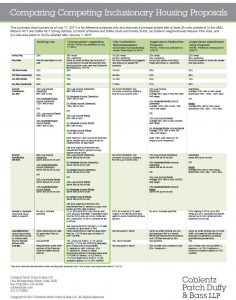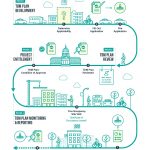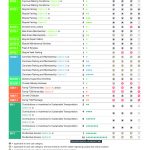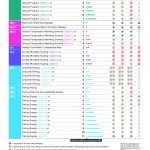The State Density Bonus law has been in effect for almost 40 years, but it has required a prolonged housing crisis to push San Francisco to adopt a local implementing ordinance. Last year the Board of Supervisors adopted the 100 Percent Affordable Housing Program for affordable housing projects, but was unable to agree on a program for market-rate projects. Supervisor Katy Tang has now introduced legislation that would consolidate existing and add new density bonus programs to local law.
The Affordable Housing Bonus Program (AHBP) renames the existing 100 Percent Affordable Housing Program and adds three new components: 1) the HOME-SF Program; 2) the Analyzed State Density Bonus Program (ADSBP), and 3) the Individually Requested Bonus Program (IRBP).
HOME-SF Program
The HOME-SF Program seeks to increase affordable housing production, especially housing affordable to middle income households. It provides incentives to sponsors of housing projects that set aside at least 30% of on-site units as affordable, including the minimum percentage and income range required under the inclusionary ordinance, and reaching the 30% threshold by providing units affordable to middle income households (defined here for ownership as an average of 120% of Area Median Income (AMI), equally distributed at 90%, 120% and 140% of AMI, and for rental as an average of 80%, equally distributed at 55%, 80% and 110% of AMI). The legislation limits the zoning districts to which the HOME-SF Program applies, and among other things, excludes the RH-1 and RH-2 Zoning Districts. It is not available where a project would demolish, remove or convert residential units, or is seeking a density bonus under one of the three other programs.
Eligible projects must establish that the project will not result in certain specific environmental impacts, will provide a unit mix that includes a higher percentage of larger units designed to accommodate families, and will include certain ground floor active uses. A qualifying project would be eligible for certain incentives, including up to 20 additional feet of height that may be used for up to two additional stories, and an additional height of up to 5 feet at the ground floor in certain cases. Projects under this program would require conditional use approval, with some specified limits on the Planning Commission’s ability to modify the project.
Analyzed State Density Bonus Program (ADSBP)
The ADSBP is based on the State Density Bonus Program, and offers a specific menu of incentives, concessions and waivers analyzed by the Planning Department and its consultants. Like the HOME-SF Program, the legislation limits the zoning districts to which the ADSBP applies. Among other things, it excludes the RH-1 and RH-2 Zoning Districts, and is not available where a project would demolish, remove or convert residential units, or is seeking a density bonus under one of the three other programs. The project sponsor must establish that the project will not result in certain specific environmental impacts, and that it meets other criteria.
A qualifying ADSBP project that provides 12% or more of its units as on-site affordable units would be eligible for a density bonus of up to 35%, and various other concessions and incentives. In some cases, a height increase of up to two stories would also be permitted. Projects with 30% or more affordable units would also be eligible for priority processing.
Individually Requested Bonus Program (IRBP)
Finally, the IRBP is available to projects that generally comply with State Density Bonus law, but are not consistent with the pre-vetted menu of concessions, incentives and waivers offered in the ADSBP, and therefore require individualized analysis. The criteria are similar to the ADSBP, except that it applies to a broader range of zoning districts (generally only RH-1 and RH-2 are excluded, except where the Code would allow 5 or more units on sites within those districts).
Qualifying projects are eligible for density bonuses up to 35%, as well as other concessions and incentives proposed by the City or the Developer that are appropriate for the project and will result in identifiable, actual cost reductions. In some cases, waivers from development standards may also be granted.
Amendments to the legislation were adopted at the March 13 Board of Supervisors Land Use and Transportation Committee hearing, and the legislation has been continued to allow time for additional public review.



